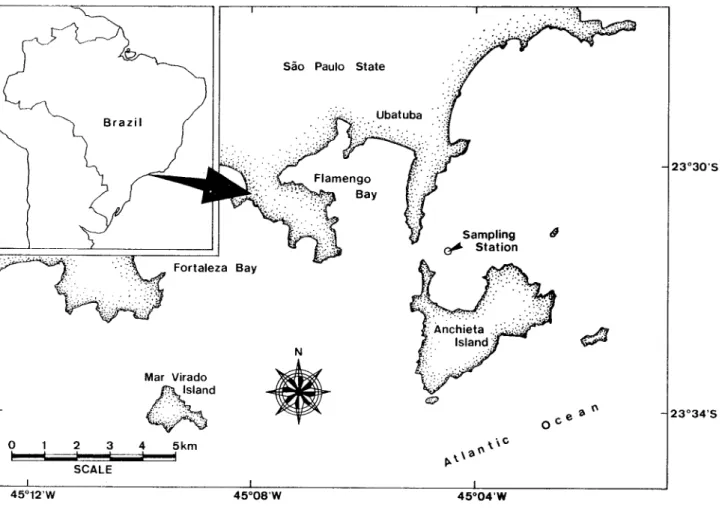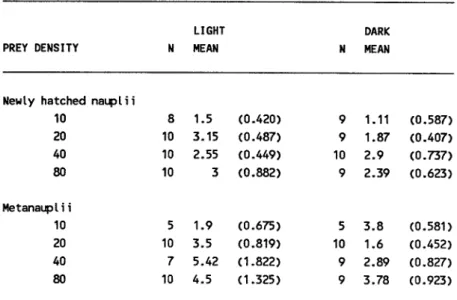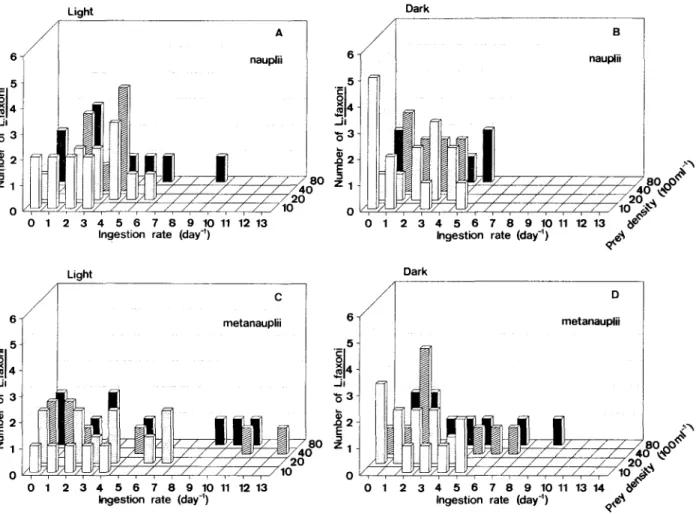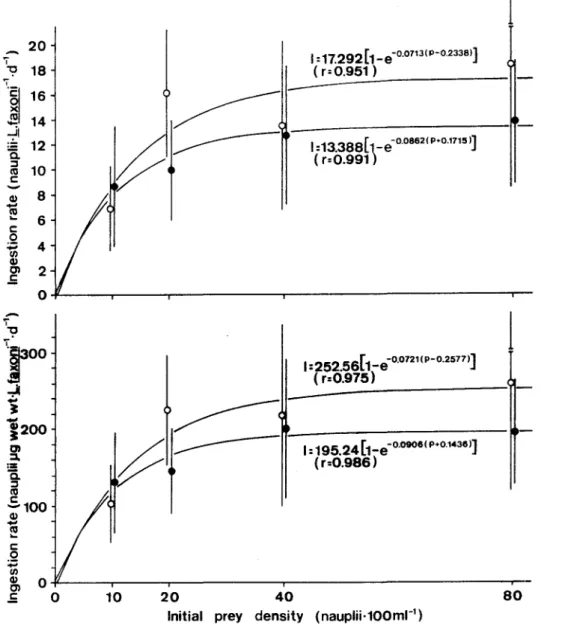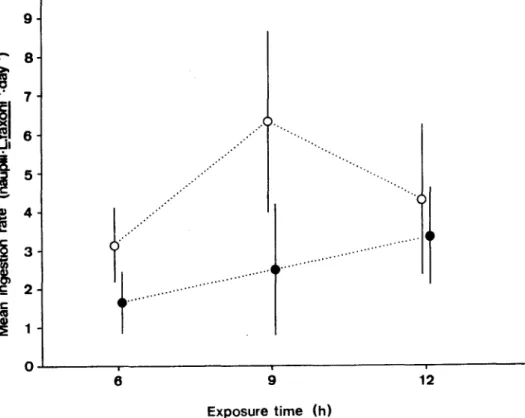Feeding of the planktonic shrimp
Lucifer fawni
Borradaile,
1915
(Crustacea:
Decapoda)
in the laboratory
Luz Amelia VEGA-PÉREZ; Koichi ARA; Tsui Hua LIANG & Marcelo Mattos PEDREIRA
Instituto Oceanográfico da Universidade de São Paulo (Caixa Postal 66149, 05389-970 São Paulo,SP, Brasil)
. Abstract: Feeding hehavior of juveniles of the planktonic shrimp Lllcifer laxoni Borradaile was studied in the laboratory under light and dark conditions. Newly-hatched nauplii and metanauplii ofArtemia were used as prey organisms. The fccding rate ofL. faxoniwas dependent on prey size and prey density, hut was not obviously affected by light or dark conditions. The capture of the prey tended to increase with longer exposure time to prey. The maximum ingestion rate was 17.28 and 13.40 nauplii.L fa.r:onr.d-I, in the light and in the dark conditions, respectivcly.
. Resumo: O comportamento alimentar de espécimens jovens de Lllcifer faxoni Borradaile, em laboratório, soh condições de luz e escuro, foi estudado utilizando-se como alimento náuplios recém-eclodidos e metanáuplios deArtemia. Neste estudo a taxa de alimentação deL. faxoni foi influenciada pelo tamanho e concentração da presa, bem como pelo tempo de contato com a mesma. A atividade alimentar deL. faxoni foi maior em condições de luz, quando comparado com as condições de escuro.
f
taxa máxima de ingestão calculada foi de 17,28 e 13,40 náuplios.L.faxonr .d- para as condições de luz e escuro, respectivamente.. Descriptors:Feeding hehavior, Predation rate, Marine camivory, Lllcifer faxoni, Zooplankton.
. Descritores:Comportamento alimentar, Taxa de predação, Camivoria, Lllcifer faxoni, Zooplâncton marinho.
Introduction
The feeding mechanisms are worth studying in order to answer hasic questions about how evolution has shaped feeding behavior and how this behavior will affect community structure and funetion (Bâmstedt, 19RR).
Carnivorous feeding of zooplankton may play an important role in the regulation of prey populations (Hopkins et ai., 1993), and consequent1y in determining community structure. Feeding behavior and energetics of carnivorous feeding of zooplankton species have been studied (Lampitt & Gamble, 1982;Yen, 1983;Reeveet ai., 1989;Oresland & Ward, 1993).
The planktonic shrimp Lllcifer faxoni Borradaile is regarded as an important component of the carnivorous
Contr. no. 793do 'nst. oceanogr. da Usp.
zooplankton in tropical and subtropical neritic waters in the Atlantic. It is abundant and wide1ydistributed in the neritie waters along the eastern coasts of North America (Hopkins, 1966; Bowman & McCain, 1967; Omori, 1977) and South America (López, 1966; Harper, 1968; Jimenez-Alvarez, 1976). In Brazilian coast it is distributed from Pará State to Lagoa dos Patos (Barth, 1963). This species have been found abundant1y in Ubatuba, São Sebastião and Cananéia regions (São Paulo State). In these localities, its role in trophodynamic pathways must be important (Vega-Pérez, 1993;1996), since it constitutes one of the most important food items found in the stomach contents of fishes (Gasalla, 1995;Wakabara et ai., 1996).
2 Rev. bras. oceanogr., 44(1),1996
This study was conducted to contribute to our undcrstanding of the fceding hchavior ofL. faxoni under laboratory conditions. The goal is to determine predation rate at different food concentrations using two sizes of prey under different light condition.
Material and methods
Zooplankton samples and seawater were collected on September 20-23,1994 offUbatuba region, São Paulo State, Brazil (Fig. 1). Oblique hauls were made using a 50511m mesh ring net of 1 m diameter, which was towed between the surface and 12 m depth for 5 min at ship velocity of ca. 1.0 - 1.5 knots. Samples were transfered into plastic containers and transported immediately to the laboratory. Juvenile females specimens ofL. faxoni (mean of total length =3.84 :t 0.99 mm; mean wet-weight=239.19:t
5ão Paulo 5tate
Fortaleza Bay
Mar Virado
~
.,;:..
:
. :.:ISla
. n
. d
,;,'," -... ,...:-. :
N
.
o
I 2~ 3 5CALE
4 I 5km!
45°12'W 45°08'W
111.90l'g) were sorted with pipette and placed individually in small glass bowls (diameter 9 em and depth 7 em), containing approximately 100 ml filtered seawater with salinity 34.00. Ali specimens were maintained at room temperature of 21.5-27.0°C in starved condition for 6h before the experiments begun.
Three aspects of feeding behavior of L. faxoni were studied: (1) influence of prey concentration; (2) effect of prey size; (3) influence of light and dark conditions.
In the feeding experiments newly-hatchedAnemia
nauplii (mean length
=
0.46 :t 0.036 mm; mean wet-weight= 14 #g) and metanaupIü (mean length
=
0.62 :t 0.042mm; mean wet-weight,
=
17.3#g) were used as the prey at four different concentrations: 10, 20, 40 and 80 individuais per bowl. These experiments were conducted for 6 h under light and dark conditions.23°30'5
5ampling c9
~
Station23°34'5
45°04'W
Additional experiments were made to determine the effect of longer exposure time (9 h and 12 h) ofL. faxoni fed with 20 newly-hatched nauplii prey. Ouring the experiment no molt ofL. faxoni was observed.
At the end of each experiment, specimens ofL. faxoni were carefully removed from the bowl, and the number of prey remaining in each bowl were counted. When the prey was partially consumed, Le. about half of body, it was registered as 0.5 individual. L. faxoni specimens were frozen after the experiments to avoid alterations in the length and weight, since the meansurements were processed in the period of 48 h.
The reIationship between the length of pre-bucal somite and totallength ofL. faxoni was observed by Lópes (1966). Pre-bucal somite was measured, from the tip to the posterior edge, under a stereomicroscope Wild M5 using a micrometer scale. Measurements of wet-weight were made with electronic microbalance (Sauter Co. Ltd., Modcl 081) by placing a known number of individuaIs on a alumnium foil.
From length and weight data ofL. faxoni, the foIlowing regression equation was obtained:
W
=
308.653L 2.489(r=
0.883),where W and L are the weight (p.g) and length (mm), respectivcly. This equation was used to calculate the weight of a singleL. faxoni.
Ivlev's equation modified by Parsons et ai. (1969) was fitted to the mean values of ingestion rates obtained from the experiments to express the functional response of the
L
.
fi
axonz. .
10 terms o naup 11f I"L.fi
axom...1d.1 d, an /1gI" L f ..1d.1 naup 11. . axom. : I
=
Imax(1-e-d(PO-p»),where I is the ingestion rate; Imax is the theoretical maximum rate of ingestion; d is the constant; p is the prey density, and po is the threshold prey density bclow which no feeding takes piare.
For alI statistical compari sons, one-way analysis of variance (ANOV A) and Tukey multiple comparison test were applicd (Sokal & Rohlf, 1981).
ResuIts
In laboratory conditions, L. faxoni generaIly ate their prey whole, although sometimes partial consumption has been observed.
Throughout the series of experiments, a large number of L. faxoni (82.09%) was observed preying on newly-hatched Artemia nauplii and metanauplii, whereas 17.91% ofthe L.faxoni had not ingested prey.
The mean values of individual ingestion rates varied with the prey size, prey density and light/dark conditions (Table 1). The number of prey ingested in the 6h experiments was variable. Nearly 70.92% of L. faxoni consumed 1-5 prey items, 9.91% captured 6-11 prey and only 0.70% ingested 13 nauplii (Fig. 2). Higher percentage of capture was verified in light conditions (Fig. 3).
Table 1. Means (:!:SE) of ingestion rates (express per day) ofL. faxoni preying upon Artemia newly-hatched nauplii and metanauplii.
LIGHT DARK
PREY DENSITY N MEAN N MEAN
Newly hatched nauplii
10 8 1.5 (0.420) 9 1.11 (0.587) 20 10 3.15 (0.487) 9 1.87 (0.407) 40 10 2.55 (0.449) 10 2.9 (0.737) 80 10 3 (0.882) 9 2.39 (0.623)
Metanaupl i i
4 Rev. bras. oceanogr., 44(1),1996
~
~
1 20
~
~
...i1 15
-
o
~
10 c:4) :J
g
... 5 u..25 Lucifer faxoni showed preference towards ingesting
larger prey (metanauplii) than small one (nauplii). The one-way ANO VA analysis applied to the ingestion rate proved significant differences. However, the Tukey multiple companson test did not prove this difference statistically except for the case when prey density was 10 nauplii.100 mr1.
Interaction effect on prey and predator was evident. Mean ingestion rates of L faxoni increased with prey densities. The rates on nauplii and metanauplii prey approached asymptotic values in both light and dark conditions, as shown in Figure 4. The calculated rate of maximum ingestion was 17.28 and 13.40 naupliiL faxonr1.d-1 for light and dark experiments, respectively.
These values were equivalent to 252.56 Jlg wet-weight naup1iiL faxonr1.d-1 in the light and 175.24Jlgwet weight naupliiL faxonr1.d-1 in the dark.
o
o 1 2 3 4 5 6 7 8 9 10 11 12 13 Ingestion rate (No. Arterna.day-1)
Fig. 2. Frequency (%) and ingestion rate (No.
Artemia.day-1) ofL faxoni.
Fig. 3.lngestion rate (express perday) ofLfaxoni preying uponArtemia nauplii (A, B) and
métanauplii (C, D), in lightanddarkconditions.
Light Dark
A B
6-( ! nauplii 61 ! nauplii
'§(
5
'§I
4 4
..JI ..JI
õ3 03
1J2
i
2l ,'...
E
80l
:> 80
Z 1 40 z 1 ' 40
20 20
oVL-V/'_-..J"/L.-Y/'__"/I I . I I '/I '/I '/F / /, / , / , / , / , /10 o 10 i,, 0 o 1 2 3 4 5 6 7 8 9 10 11 12 13 O 1 2 3 4 5 6 7 8 9 10 11 12 13
Ingestion rate (day-') Ingestion rate (day-') 0
Light Dark
C D
6-( metanauplii 61 metanauplii
'815
5
'§I
4 4
..JI ..JI
03 õ3
1J2
tJ III
1/..ro#P
E
:>80
Z 1 An
20 O I/L..-Y/l....-.->'/.__.'/'__.//I I , I I I / I '/j / I /I / , '/I / I / I / lU O1/, '/" /I...V/I...V/L.-Y/I...V/'" / / """/ / / / / '/ 10(;f';t-4.
O 1 2 3 4 5 6 7 8 9 10 11 12 13 O 1 2 3 4 5 6 7 8 9 10 11 13 14
1
I :17.292[1_e-o.o713(P-o.2338)]
( r=0.951 )
I :13.388( 1_e-o.o862(P+O.1715)]
( r=0.991 )
1
I :252.56[ 1_e-O.0721 (P-O.2577)]
( r=0.975)
~..-~'
f
"
1:195.24[1_e-O.0906(P+O.1436)]
/ /
(r=0.986)10 20 40
Initial prey density (nauplii-100mr1)
80
Fig. 4. Ingestion rate ofL faxoni on different prey density (lvIev's function), in light(o) and dark( 8 ) conditions.
The other experiments made to determine the effect of longer exposure time (9 h and 12 h), utilizing 20Artemia nauplii, showed that the capture tended to increase with longer exposure time to prey (Fig. 5). Tukey multiple comparison test showed the differences in the 6 h and 9 h experiments under light conditions were statistically significant. For the other trials, the differences were not statistically significant.
In all experiments the mean ingestion rate was higher in the light conditions, although they were not statistica1ly significant (p < 0.05).
Discussion
In laboratory conditions, L faxoni generally ate their preywhole, but the partial consumption was also observed.
These feeding behavior has been reported in other crustaceans such as the prawn Crangon crangon(Gibson et ai., 1995).
The number of prey ingested by L. faxoni in the laboratory was bigh1yvariable ranging from Oto13Artemia nauplü. Nearly 17.9% did not feed. The reason for this large variation could be due to the physiological state ofL. faxoni since feeding can vary due to stress of collection and acclimation period (Chow-Fraser, 1986).
Prey size is one of the severa! factors affecting prey encounter rate and the predator ability and willingness to capture and ingest prey (Oresland & Ward, 1993). In this study, L. faxoni preyed more efficient1y on Artemia metanauplii than on newly- hatched nauplii. The difficulty in capturing the nauplü may be due to the inability of tbis
--
20'i 1? 18 'i
. 16
14 I
12
ã.;:,
10 m I:
--Qj 8
"iií a-6 I: o :;:;fi) 4
Qj CI 2 .5
O
--'i"tJ
íroo -"ií200
CI :J,
:= ã.;:,m
.s 100Qj
-
m
a-I: o :;:;fi)
Qj O
6 Rev. bras. oceanogr., 44(1),1996
.'
... ...
'. '.
...
6 9 12
Exposure time (h)
Fig. 5. Mean ingestion rate (express perday) ofL. faxoni,with relation of exposure time to newly-hatched Artemia nauplii, in light(o) and dark( 8 ) conditions.
species to manipuIate smaller prey, as reported for other prawns (Wassenberg & Rill, 1993; Gibson, 1995). Another possible explanation for this result is that Artemia metanauplii are able to swim more actively than nauplii and then, they wouId be detectable at a greater range. This is probably because of the disturbances caused by the beating of the swimming appendages or by the prey's presence in the swimming current of the predator (Landry, 1978; Ohman, 1988).
Another factor which affects the ingestion rate is the abundance of food (Valiela, 1984). In this study, higher prey densities resulted in higher ingestion rate, but the relationship curve was asymtoptic. Leeet ai.(1992) showed that the ingestion rate of adult females of L foxoni increased with increasing food density, and it did not appear to saturate at higher food concentration (100 nauplii.r1) in the laboratory condition.
The ingestion rate was slightly higher in the ligbt conditions than dark condition, it was not significantly different, however, between ligbt and dark experiments, indicating that perceptions of prey may occur without visual cues. Besides visual perception, the detection of prey for the L foxoni would be a chemo- or mechanoreception processo Although at present little is known about the
relative importance of chemo- and mechanoreception in predator recognition.
In this study longer exposure time of predator to the prey tended to increase the number of Artemia captured by L foxoni. These results confirm that food will be successfully captured when the feeder is exposed longer to the presence of its food (Andrews, 1983).
The information obtained in this study confirms that further field and laboratory studies on feeding rate of L faxoni are required for better understanding the potential contribution of this species to the marine secondary production in the studied region.
Acknowledgments
We are grateful to Dr Jefferson T. Turner (University of Massachusetts
-
Dartmouth) and two anonymous reviewersfor their critical comments on the manuscript. We would also thank Dr Y. Matsuura (InstitutoOceanográfico
-
USP) for his help in the analysis ofnonlinear parameter estimation and M.Sc. N. Chung for the English review. This research was supported by Brazilian govemment through CNPq and CAPES.
9 .... 8
j' 7
'§I 6
f
5--CI) 4
e
3
t
. 2
c:
IV
1
References
Andrews, J. C. 1983. Deformation of the active space in the low Reynolds number feeding current of calanoid copepods. CanoJ. Fish. aquat. Sei., 40:1293-1302. Bãmstedt, U. 1988. Ecological significance of individual
variability in copepod bioenergetics. Hydrobiologia, 167/168:43-59.
Barth, P. 1963. Estudos sobre Lucifer reynaudi como indicador de águas tropicais. Notas Tecn. Inst. Pesq. Mar., Rio de Janeiro, 12:1-16.
Bowman, T. E. & McCain, J. C.1967. Distribution ofthe planktonic shrimp Lucifer in the westem North Atlantic. Bull. mar. Sei., 17:660-671.
Chow-Fraser, P. 1986. Effect of collection and acclimation period on grazing rates of limnetic zooplankton. Hydrobiologia, 137:203-210.
Gasalla, M. A. 1995.Organização trófica da ictiofauna do Saco de Mamanguá, Parati, Estado do Rio de Janeiro. Dissertação de Mestrado. Universidade de São Paulo, Instituto Oceanográfico. 145p.
Gibson, R N.; Yin, M. C. & Robb, L. 1995. The behavioural basis of predator-prey size relationship between shrimp (Crangon crangon) and juvenile plaice(Pleuronectesplatessa). J. mar. biol. Ass. U .K., 75:337-349.
Harper Jr, D. E. 1968. Distribution ofLucifer faxoni (Crustacea: Decapoda: Sergestidae) in neritic waters off the Texas coast, with a note on the occurrence of Lucifertypus. Contr. mar. Sei. Univ. Tex., 13:1-16. Hopkins, T. L. 1966.The plankton of the SI. Andrew Bay
system, Florida. Publs Inst. Mar. Sei. Univ. Tex., 11:12-64.
Hopkins, T. L.; Lancraft, T. M.; Torres, J. J. & Donnelly, J. 1993. Community structure and trophic ecology of zooplankton in the Scotia Sea marginal ice zone in winter (1988). Deep-Sea Res., 40:81-105.
Jimenez-Alvarez, M. P. 1976. Distribuição vertical e estágios de desenvolvimento de Lucifer foxoni
Borradaile (Crustacea) ao largo de Santos. Dissertação de Mestrado. Universidade de São Paulo, Instituto de Biociências.54p.
Lampitt, R. S. & Gamble, J. C. 1982.Diet and respiration of the smalI planktonic marine copepod Oithona nana.Mar. Biol., 66:185- 190.
Landry, M. R 1978. Predatory feeding behavior of a marine copepod, Labidocera trispinosa. Limnol. Oceanogr., 23:1103-1113.
Lee, W. Y.; Omori, M. & Peck, R. W. 1992. Growth, reproduction and feeding behavior of the planktonic shrimp, Lucifer faxoni Borradaile, off Texas coast. J. Plankt. Res., 14:61-69.
López, M. T. 1966.Biología deLucifer foxoni Borradaile, 1915, en Canan~ia, Brasil (Crustacea, Decapoda, Luciferidae). Bolm Inst. oceanogr., S Paulo, 15:47-54. Ohman, M. D. 1988.Behavioral responses of zooplankton
to predation. Bull. mar. Sei., 43:530-550.
Omori, M. 1977. Distribution of warm water epiplanktonic shrimps of thegeneraLucifer andAcetes (Macrura, Penaeidea, Sergestidae). In: PROC.
SYMP. WARM WATER ZOOPLANCKTON.
Unesco/NIO, 1977. p. 1-12.
Oresland, V. & Ward, T.1993. Summer and Winter diet of four camivorous copepod speeies around South Georgia. Mar. Ecol.-Prog. Ser., 98:73-78.
Parsons, T. R.; Lebrasseur, RJ.; Fulton, J. D. & Kennedy, O. D. 1969.Production studies in the strait of Georgia. Part 11.Secondary production under the Fraser River plume, Februaryto May, 1967.J. expl mar. Biol. Ecol., 3:39-50.
Reeve, M. R; Syms, M. A. & Kremer, P. 1989. Growth dynamics of a ctenophore (Mnemiopsis) in relation to variable food supply. I. Carbon biomass, feeding, egg production, growth and assimilation efficiency. J. Plankt. Res., 11:535-552.
Sokal, R R & Rohlf, F. J. 1981. Biometry. San Francisco, W. H. Freeman & Co. 859p.
Valiela, I. 1984. Marine Ecological Processo New York, Springer- Verlag. 546 p.
8 Rev. bras. oceanogr., 44(1),1996
Vega-Pérez, L. A. 1996. Estudo do zooplâncton da plataforma interna da região de São Sebastião. In: Oceanografia da Plataforma Interna da Região de São Sebastião. Relatório FAPESP nQ3. 664p. Wakabara, Y.; FIynn, M. N. & Tararam, A. S. 1996.
Consumption and seIection of superbenthic crustaceans by smaIl-sized fishes in a lower salt marsh system. Rev. bras. oceanogr. (Submitted).
Wassenberg, T. J. & HilI, B. J. 1993. Diet and feeding behavior of juvenile and aduIt banana prawns Penaeus merguiensis in the Gulf of Carpentaria, Australia. Mar. Ecol.-Prog. Ser., 94:287-295. Woodmansee, R. A. 1966a. Daily vertical migration of
Lucifer(Decapoda, Sergestidae). Egg development, oviposition and hatching. Int. Revue ges. Hydrobiol., 51:689-698.
Woodmansee,R..A. 1966b. Daily vertical migration of Lucifer planktonic numbers in relation to solar and
tidaI cycles. Eco10gy,47(5):847-850.
Yen, J. 1983. Effects of prey concentration, prey size, predator tife stage, predator starvation, and season on predation rates of the carnivorous copepod Ellchaeta elongata.Mar. Biol., 75:69-77.
